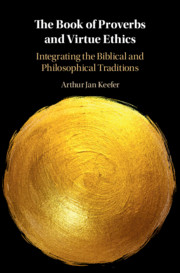Book contents
- The Book of Proverbs and Virtue Ethics
- The Book of Proverbs and Virtue Ethics
- Copyright page
- Dedication
- Contents
- Tables
- Preface
- Note on Texts and Translation
- Abbreviations
- 1 Introduction
- 2 Views of Virtue in Philosophy
- 3 Moral Virtues in Proverbs
- 4 Honor, Shame, Humility, and Pride
- 5 Courage, Work, Speech, and Friendship
- 6 Theological Virtues in Proverbs
- 7 Moral Agents and the Presentation of Virtue
- Bibliography
- Index of Ancient Sources
- Index of Authors and Topics
3 - Moral Virtues in Proverbs
Published online by Cambridge University Press: 22 October 2020
- The Book of Proverbs and Virtue Ethics
- The Book of Proverbs and Virtue Ethics
- Copyright page
- Dedication
- Contents
- Tables
- Preface
- Note on Texts and Translation
- Abbreviations
- 1 Introduction
- 2 Views of Virtue in Philosophy
- 3 Moral Virtues in Proverbs
- 4 Honor, Shame, Humility, and Pride
- 5 Courage, Work, Speech, and Friendship
- 6 Theological Virtues in Proverbs
- 7 Moral Agents and the Presentation of Virtue
- Bibliography
- Index of Ancient Sources
- Index of Authors and Topics
Summary
Biblical interpreters assume that the moral concepts in Proverbs resemble virtues as understood by moral philosophers, especially Aristotle. No study, however, has considered how the moral-philosophical criteria for defining virtue compare to the concepts in Proverbs. I argue that Proverbs’ moral instructions (focusing on Proverbs 10-29) cohere with Aristotle’s understanding of moral virtue and vice in the Nicomachean Ethics, including his notion of the mean. That is, certain concepts in Proverbs are virtues and vices in the Aristotelian sense. To demonstrate this, I argue that (1) virtues of action and emotion in Proverbs are identifiable through praise and blame; that (2) the vices reflect excess and deficiency in action and emotion; and that (3) the virtues “hit the mean” of these actions and emotions.
Keywords
- Type
- Chapter
- Information
- The Book of Proverbs and Virtue EthicsIntegrating the Biblical and Philosophical Traditions, pp. 42 - 92Publisher: Cambridge University PressPrint publication year: 2020

